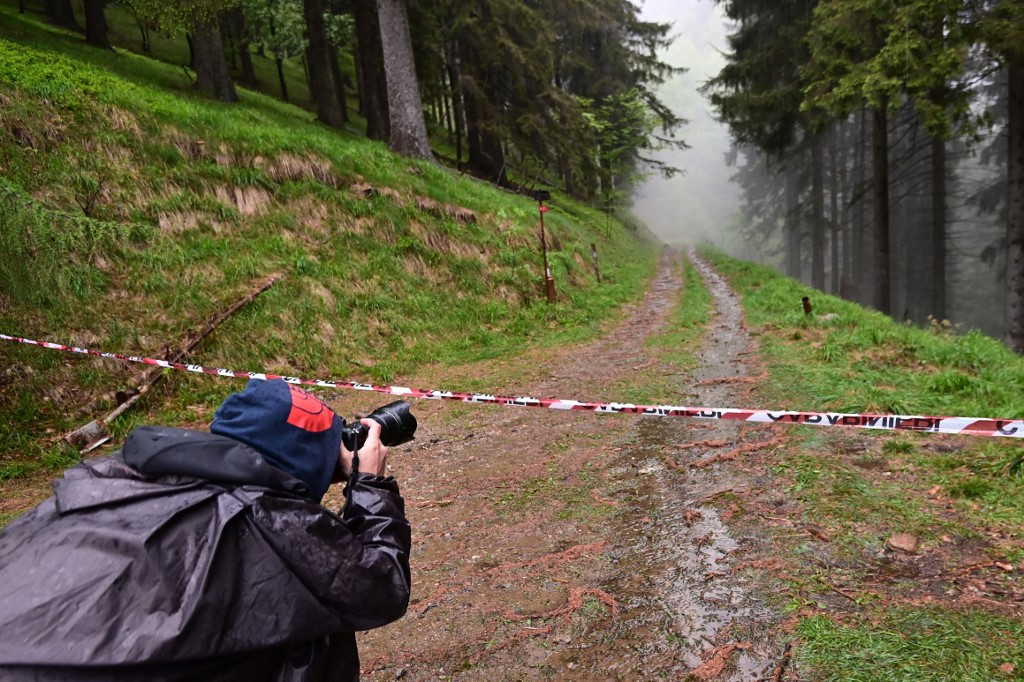
A view taken on May 24, 2021 shows a photographer working by a cordoned off access below the arrival building of the Stresa to Mottarone cableway at the Mottarone peak, Piedmont, a day after a cable car accident killed 14 people. (Photo by MIGUEL MEDINA / AFP)
STRESA, Italy — Investigators were on Monday probing the causes of a horrific cable car crash in the Italian mountains that left 14 people dead and a five-year-old child as the sole survivor.
The boy, who lost his parents, grandparents and two-year-old sibling in Sunday’s accident, was hospitalized in a critical condition, but there were hopes for his recovery.
“He is still under intensive care, intubated and sedated … Tomorrow, doctors will slowly try to wake him up and are cautiously optimistic,” a spokesman for the Citta della Salute hospital in Turin told AFP.
The accident took place near the summit of the Mottarone mountain, a scenic location overlooking Lake Maggiore in the northwest region of Piedmont. A nine-year-old boy was also among the victims.
The cable car crashed to the ground after a cable broke, according to first reports, while several officials, including a member of the emergency services and a prosecutor, said the security brake failed to function.
“There are various aspects of this affair that will certainly be clarified,” Transport Minister Enrico Giovannini said after visiting Stresa, the town at the base of the cable car.
Prosecutors opened an investigation Sunday into potential charges of involuntary manslaughter, while a government-commissioned inquiry by technical experts was also under way.
Leitner, the company in charge of maintenance, said the brake system was last checked on May 3, while a simulated emergency, involving a cable breakage and the activation of the emergency brake, was successfully conducted in December.
Several other tests and maintenance work was done in recent months “as prescribed by current legislation”, Leitner said, vowing to help investigators “find as soon as possible the causes of the terrible tragedy”.
It was the first fatal incident involving a cable car in Italy since 1998, when a low-flying US military jet severed a cable at a ski resort, killing 20 people.
It came at the start of the country’s much-anticipated reopening to tourists after coronavirus closures.
‘We don’t know why’
The fatal accident near the end of the 20-minute ride up the mountain may have had a dual cause, according to the regional head of Italy’s alpine rescue team, Matteo Gasparini.
“They are all suppositions, but I think there has been a double problem, the breakup of the cable and the non-working of the emergency brake,” he told La Stampa daily.
“We don’t know why it didn’t activate, while in the downstream car it worked.”
That meant the cable car began quickly falling back and picking up speed before it “ended up catapulted out of the support cables”, Gasparini said.
The cable car hit a pylon, then hit the ground, tumbling down the mountain for about 500 meters (1,600 feet), before coming to a stop, according to news reports.
Rescuers found five bodies still inside the cable car, with the others strewn outside.
The young survivor, whose parents were born in Israel and were residents in Italy, was immediately airlifted to the Turin hospital.
He suffered injuries to his skull, chest and abdomen and various leg fractures, media reports said.
The child’s aunt and other set of grandparents were at his bedsite.
Latest accident
An expert in technical construction at the Polytechnic University of Milan, Gianpaolo Rosati, told AFP it would take time before laboratory tests on the cable’s mechanisms, including the snapped cable itself, were completed.
He said the cable could have been corroded, or overused, but added: “Usually there is not one sole cause, but a series of causes that unfortunately combine in the worst way and cause a tragedy.”
The head of Italian consumer protection group, Codacons, said the accident was “just the latest serious incident” involving the transport sector, a list that includes the 2018 collapse of a major highway bridge in Genoa that killed 43 people.
“After the massacre of the (Genoa) Morandi Bridge, the derailments of trains, the seizures of bridges and viaducts at risk throughout Italy, the shipwrecks of cruise ships, it is clear that in our country something is not working in terms of transport safety controls,” Codacons President Carlo Rienzi said in a statement.